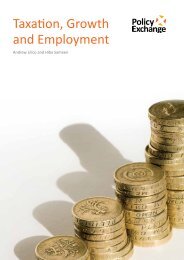PRESS RELEASE
PRESS RELEASE - Policy Exchange
PRESS RELEASE - Policy Exchange
- No tags were found...
Create successful ePaper yourself
Turn your PDF publications into a flip-book with our unique Google optimized e-Paper software.
<strong>PRESS</strong> <strong>RELEASE</strong><br />
Embargoed until 00.01<br />
Thu, 17 Mar 2011<br />
Report calls for planning shake-up<br />
to make way for tens of thousands of new homes<br />
Making it easier to turn currently vacant or under used offices and shops into housing could create tens<br />
of thousands of new homes and provide a powerful boost to the economy, according to new research<br />
published today by leading think tank, Policy Exchange.<br />
The study – More Homes: Fewer Empty Buildings – calls for allowing vacant or under used retail,<br />
industrial and office space to be converted into housing, without having to obtain planning permission<br />
for change of use.<br />
Authors Alex Morton and Richard Ehrman show that despite the current housing crisis, there are<br />
currently 266,000 vacant commercial units, many of which have outlived their usefulness.<br />
Alex Morton said: “Councils are holding back the conversion of vacant and under-used urban space into<br />
housing. Relaxing the planning rules to make it easier to convert commercial property would encourage<br />
investment, increase regeneration and create large numbers of jobs.<br />
“We have rates of vacancy among commercial buildings nearly six times that of empty housing. That is a<br />
major indictment of our current system.<br />
“Just because a building has always been a shop or offices shouldn’t have to mean it stays that way<br />
forever.”<br />
Problems with the current system are underlined by the huge discrepancy between the vacancy rates<br />
for commercial and residential property. Around 3% of houses are currently empty nationwide, while<br />
even in the economically-vibrant South-east England, office vacancies are running at 17%.<br />
The plans would mean tatty shopping centres and parades could be a thing of the past. Many vacant<br />
retail or employment spaces are now no longer viable because of changing retail and business patterns.<br />
Internet shopping now makes up 10% of all purchases and is growing fast. Meanwhile changing<br />
employment needs mean older office buildings that are not suitable for open-plan spaces, air<br />
conditioning or computer-cabling are much less in demand.<br />
Yet these premises, which might make good homes, are currently often left empty or even derelict<br />
because planning policy impedes their conversion to housing. The interests of existing business
occupiers would be protected because only vacant or part vacant premises could be converted without<br />
permission.<br />
Conversion without the need for planning permission would only be to housing – meaning residents<br />
would still be protected against new fast-food outlets or off-licenses.<br />
Many of the new homes expected to be built if the rules are relaxed could be ideal for first-time buyers<br />
finding it harder than ever to get on the housing ladder. In 2008, some 16,000 homes were converted<br />
from redundant commercial premises. By freeing-up the system, the authors expect that figure could be<br />
multiplied many times.<br />
Key proposals in the study include:<br />
• Any A (retail, eg shop) or B (eg offices) Class building or land that has been vacant for more<br />
than a year should be allowed to change to C3 housing without the need for planning<br />
permission.<br />
• If an A or B class building has been vacant for less than a year, up to 50% of the overall floor<br />
space should be allowed to convert to C3 in any five year period without the need for<br />
planning permission.<br />
• Village shops and pubs would be protected by only allowing bureaucracy-free conversions if<br />
there are other such businesses within a mile of the proposed conversion until the new<br />
Community Right to Buy is established.<br />
• Measures would be included to ensure that “windfall” planning gains are shared fairly<br />
between the local community and developers using existing mechanisms like the<br />
Community Infrastructure Levy and New Homes Bonus.<br />
About the authors<br />
Alex Morton was Secretary to the Conservative Globalisation and Global Poverty Policy Review 2005-<br />
2007. Following a period in the civil service, he joined Policy Exchange in 2010 as a Senior Research<br />
Fellow on Housing and Planning issues, and wrote Making Housing Affordable, Prospect’s 2010<br />
ThinkTank Publication of the Year.<br />
Richard Ehrman was a Government Special Adviser in the 1980s and subsequently Chief Leader Writer of<br />
the Daily Telegraph. He is the Deputy Chairman of Policy Exchange and has interests in commercial<br />
property.<br />
ENDS<br />
To download a copy of the report, click here:<br />
http://www.policyexchange.org.uk/assets/More_Homes.pdf<br />
For further information, please contact Gabriel Milland on 07860 552 621 or<br />
gabriel.milland@policyexchange.org.uk





